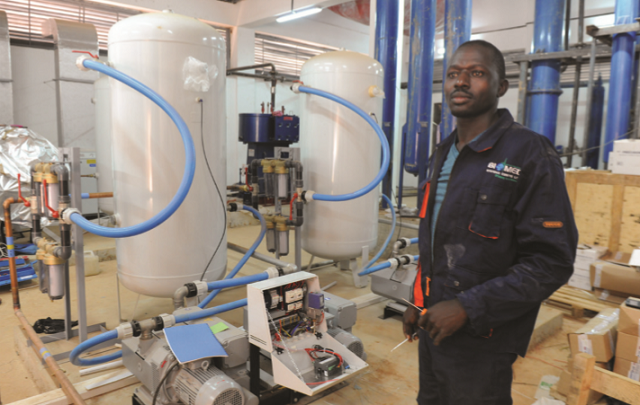
Renovated old Mulago
Constructing the hospital is part of a bigger plan initiated in 2014 to de–congest and renovate Mulago National Referral Hospital. The facility constructed in the 1960s had become associated with dilapidated structures, long patient queues, and poor care. A loan of $50 million was sought from the African Development Bank to rehabilitate it.
When the Independent visited the site on Aug. 09, minor works were going on with many workers seen cleaning walls in preparation for painting. The 27 bed adult Intensive Care Unit (ICU), 15 bed children ICU and 8 theatre halls have been made spacious to meet international standards. Also renovated are the children’s ward and the mortuary. Like the women’s wing, admission at this facility will be segregated into class; with platinum having 6 rooms, gold – 45 rooms, VVIP – 4 rooms and general wards – 700 beds. It will all depend on how much one pays. For those who are not able to pay, a national health insurance will hopefully be available to fill in for them.
Dr. John Mark Kasumba, an anesthesia and critical care specialist told The Independent that when the hospital re-opens in December, it will mark a milestone in the country’s medical care as organ transplant will also start.
Kasumba, who is one of the 15 specialists who have been trained in India to conduct such procedures, was showing off the kidney transplant theatre area. He says it is equipped to cater for the 70 patients waiting with dialysis (artificial blood purifying). Many of these are currently at the Mulago extension facility at Kiruddu.
Two theatre rooms have been prepared for procedures on both the donor and recipient. These rooms that are connected to ensure the organ is transported without any interferences will be kept under strict sanitary and air conditioning standards. In the same area are self-contained wards made to ICU standard where a recipient will stay for seven- days after the procedure and the donor for 48 hours.
“As you can see there’s no window. The air here is totally conditioned. It is channeled specifically to move in a unidirectional manner technically called lamina flow to prevent recirculation of bacteria into the surgical area,” Kasumba explains. He says the hospital initially had five theatres but it now has eight, yet they no longer need big machines since, with modern equipment, control will be done in one area. Kasumba says student doctors will also no longer be allowed into theatre rooms. Instead, they will observe procedures from live feeds in rooms outside theatres. “The only equipment that will sit on the ground will be the operating table,” Kasumba adds. The floor finish in this area will be vinyl because bacteria do not grow on it and it can be easily cleaned as it does not crack as pocylene does.
Mulago hospital Executive Director, Dr. Byarugaba Baterana, says two CT scans are replacing the old one at the radiology department and two MRI scans – equipment that use a large magnet and radio waves to look at organs and structures inside the body and eight fluoroscopy equipment that provide high level X-ray.
With construction of the top notch medical care facility almost complete, Baterena is focusing on the next challenges; what can be done to ensure that we do not return to the old Mulago standards? What will one need to access treatment? Will the current human resource match the new standard?
The rule is patients will visit on appointment and will require a national identity card to acquire services
“This Mulago hospital will not take in everybody. Patients coming in here will only be referred,” Baterena says, ““People should be able to pay something.”
As an example, if a kidney transplant in India which is one of the cheapest goes for $20,000 (about Shs72 million), Baterana says the price is likely to be half at Mulago.
Baterana says the complex requires a 2000 – strong staff of doctors, specialists, nurses and support staff who are able to use the yet to be installed telemedicine apps and the Integrated Hospital Management System that will link to extension facilities in Kiruddu and Kawempe. Already, a 66km of fibre optics cable is in place and paper files are being replaced by paperless technology and control room communication.
Baterana says he has a shortage of about 300 staff to add on the current 1746; comprising 25 senior consultants, 45 consultants, and 192 medical officers. The rest are administrators, interns and masters’ students.
“Our goal is to see that the number of those seeking care outside Uganda reducing and eventually stopping. I need 70 senior consultants for this,” he says.
The areas that need urgent filling, according to him, are especially in the new unit of organ transplanting where a single procedure needs over 10 people; including standby specialists and surgeons, anesthetists, and critical care nurses. Kasumba says the most needed are vascular surgeons; to connect blood vessels. These are crucial in organ transplanting. So far, there are only two such surgeons trained in the area of kidney transplantation. The other two are trained in heart surgery.
Another area to be revamped is the neurosurgery unit which deals with brain and skull reconstruction. Dr. Micheal Muhumuza who heads this unit says they are only three neurosurgeons yet the cases of trauma are on an increase. For him the ideal for the start would at least be 10.
Baterana says two neurosurgeons are being trained and are set to graduate in September and that $1 million had been put aside for training staff. Up to 1000 have already acquired basic computer skills, and awaiting training on how to use the new equipment and the telemedicine app.
“The companies giving us machines have to train our staff as a condition for procuring from them,” he said.
Mulago’s fate is being watched closely by NGO leaders like Moses Mulumba of the Center for Health Human Rights and Development (CEHURD). He told The Independent that having a beautiful structure with no matching staff is a waste of resources.
“If we have borrowed, there’s need for matching investment on infrastructure and human resource if we are to get value for this money,” he said.
****
 The Independent Uganda: You get the Truth we Pay the Price
The Independent Uganda: You get the Truth we Pay the Price


